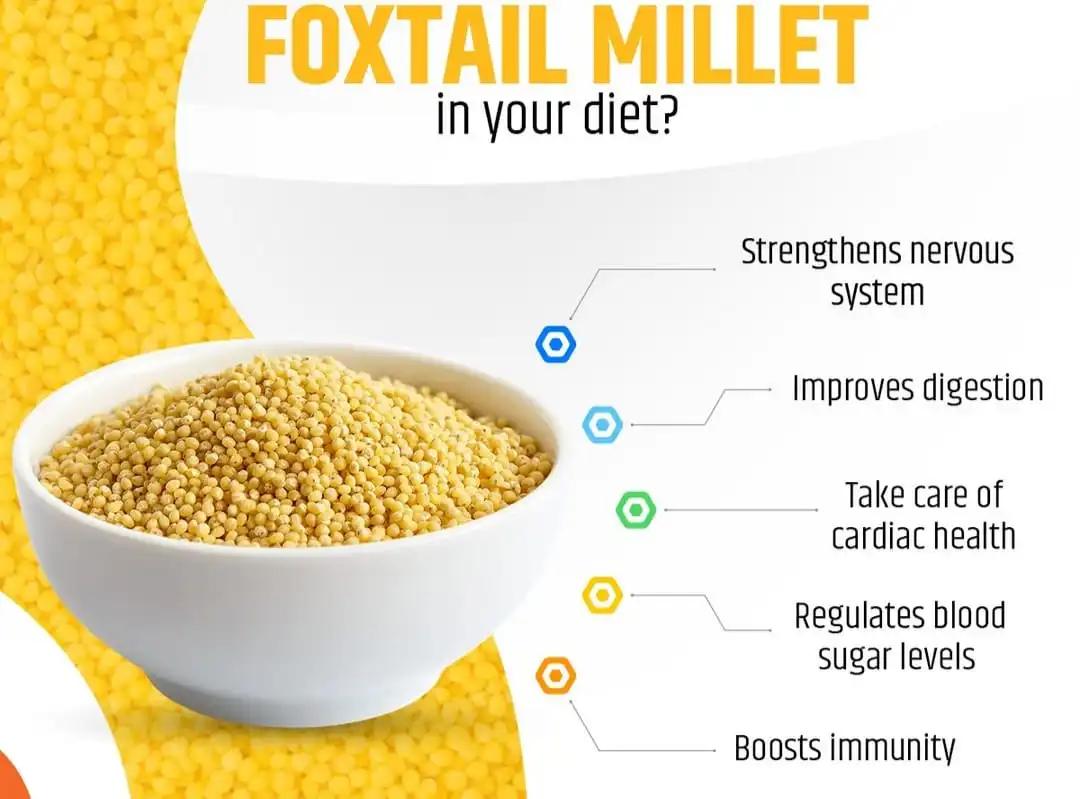Introduction
In recent years, the world has seen a revival of ancient grains and one such grain gaining popularity is foxtail millet. Known for its impressive nutritional value, versatility in cooking, and health benefits, foxtail millet is making its way into kitchens, especially among health conscious individuals.
Let’s dive deep into the many benefits, uses, and reasons why foxtail millet deserves a place in your daily diet.
What is Foxtail Millet?
Foxtail millet (botanical name: Setaria italica) is one of the oldest cultivated millets, originating in Asia over 8000 years ago. It’s a small, yellowish grain that resembles a fox’s tail when fully grown hence the name. It thrives in dry, arid climates and is widely grown in parts of India, China, and Africa.
Millets like foxtail were once considered poor man’s food, but today, they are being rediscovered as superfoods due to their impressive health benefits.

Nutritional Profile of Foxtail Millet
Foxtail is a powerhouse of nutrients. Here’s a quick look at what it offers:
- Rich in Protein: Helps in tissue repair and muscle development.
- High Fiber Content: Aids digestion and supports gut health.
- Low Glycemic Index: Suitable for diabetics.
- Gluten-Free: Ideal for those with gluten intolerance.
- Loaded with Micronutrients: Contains iron, magnesium, phosphorus, and vitamin B6.
Just 100 grams of cooked foxtail millet provides around:
- Calories: 150–170
- Protein: 6–7 grams
- Fiber: 3–4 grams

Health Benefits of Foxtail Millet
Let’s explore the health benefits that make foxtail millet a must include in your diet:
1. Supports Heart Health
Foxtail contains magnesium and other essential nutrients that help regulate blood pressure and reduce bad cholesterol. Its high fiber content supports overall heart function.
2. Manages Blood Sugar Levels
Thanks to its low glycemic index, foxtail millet releases glucose slowly into the bloodstream. This helps in managing type 2 diabetes and avoiding sugar spikes.
3. Aids Weight Loss
If you’re on a weight loss journey, foxtail millet can be your ally. It keeps you full for longer, reduces hunger pangs, and helps prevent binge eating.
4. Boosts Immunity
Packed with antioxidants, this grain strengthens the immune system and helps your body fight infections.
5. Improves Digestion
Its dietary fiber promotes regular bowel movements, reducing constipation and enhancing gut health.
6. Gluten-Free Alternative
Foxtail is naturally gluten-free, making it a perfect choice for those with celiac disease or gluten sensitivity.
How to Use Foxtail Millet in Cooking
The best part about millet is how versatile it is in the kitchen. You can use it just like rice or quinoa.
Popular Foxtail Millet Recipes:
- Foxtail Millet Upma: A wholesome breakfast option with vegetables and spices.
- Millet Pongal: A comforting South Indian dish using lentils and foxtail millet.
- Foxtail Khichdi: One-pot meal loaded with vegetables and mild spices.
- Millet Dosa or Idli: Fermented dishes using millet for a healthy twist.
- Salads and Bowls: Use cooked millet as a base for nutrient-rich salads.
Before cooking, rinse the millet thoroughly and soak it for 30 minutes. Cook with a 2:1 water-to-millet ratio for a fluffy texture.
Foxtail Millet vs. Other Grains
Compared to white rice or wheat, millet offers more protein and fiber and has a much lower glycemic index. While quinoa has become popular globally, millet is locally grown in many countries and is more affordable and sustainable.
Who Should Eat Foxtail Millet?
Foxtail is suitable for:
- People managing diabetes or obesity
- Children and elderly for overall nourishment
- Athletes for energy and protein
- Individuals on a gluten-free diet
However, moderation is key. While it’s healthy, balance it with other grains and food groups for optimal nutrition.
Environmental Benefits of Growing Millets
Millet is not just good for your body it’s good for the planet too. It requires less water, grows in poor soils, and doesn’t need chemical fertilizers. Including more millets in your diet encourages sustainable agriculture and supports rural farmers.
Tips for Buying and Storing Foxtail Millet
- Buy from trusted sources: Organic or locally grown varieties are best.
- Storage: Store in airtight containers in a cool, dry place. You can also refrigerate it to extend shelf life.
- Check packaging: Look for certifications and ensure there’s no moisture or insect infestation.
Conclusion
In a world where fast food and processed grains dominate the market, foxtail millet is a refreshing return to wholesome, traditional eating. Whether you’re aiming for better health, weight loss, or sustainable food choices, this ancient grain checks all the boxes.
Try adding foxtail millet to your weekly meals and experience the difference yourself!
Frequently Asked Questions (FAQ)
Q1. Is foxtail millet good for daily consumption?
Yes, foxtail is safe and beneficial for regular consumption. Just ensure it’s part of a balanced diet.
Q2. Can diabetics eat foxtail?
Absolutely! Foxtail has a low glycemic index, making it a suitable choice for people with diabetes.
Q3. Does foxtail help in weight loss?
Yes. It is high in fiber and keeps you full longer, which can help manage hunger and support weight loss.
Q4. How does foxtail taste?
It has a mild, nutty flavor and a slightly chewy texture when cooked similar to couscous or quinoa.
Q5. Is foxtail safe for kids?
Yes, it’s a nutritious option for children and can be introduced as porridge, dosa, or idli.
If you’re looking for a wholesome grain that is nutritious, diabetic-friendly, gluten-free, and easy to cook, foxtail millet should be on your grocery list today.